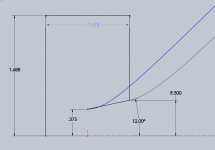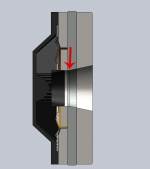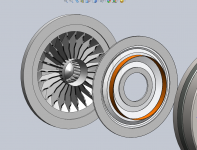WHG,
Africa will be the low cost labor source next. How long this will take I don't know but that is where it will happen next.
Africa will be the low cost labor source next. How long this will take I don't know but that is where it will happen next.
Population
If a "made in" change is to occur I suspect it would be India. WHG
Population
Rank Country/Continent Population (millions)
1 China 1,362
2 India 1,252
2a Africa 1,111 (not a single political entity)
3 United States 321
WHG,
Africa will be the low cost labor source next. How long this will take I don't know but that is where it will happen next.
If a "made in" change is to occur I suspect it would be India. WHG
Population
Rank Country/Continent Population (millions)
1 China 1,362
2 India 1,252
2a Africa 1,111 (not a single political entity)
3 United States 321
Following your comment on the horn throat and the section in the compression driver from the phase plug that is a reason that I say that the flat pancake drivers are advantageous over the traditional Alnico types of drivers with long throats sections. I agree that the shortest section possible between the end of the driver and the conic section of the horn is important and if the C-bezier curvature can create the shortest section and remain tangent at both ends of the curvature then I'll agree with your position. At the same time the variations of the actual curvature between the different bezier curves is really minor from the paper that you presented earlier.
What about machining the throat of the driver to begin the curve right at the phase plug exit? I'm looking at building new waveguides next year so I thought I'd do more study and modeling over the winter. Looking at my BMS 4552nd they have a fairly short throat with a wide angle: iirc it's about .5" deep with a 24deg angle and the dia at the phase plug exit is about .75". There's enough material there to machine the start of the os curve with a 45deg wall angle.
My only concern is loading on the low end with a shorter length and a more rapid flare at the throat. If it didn't work out I could always bore that section out and have a plug 3d printed to restore the original shape....
What about machining the throat of the driver to begin the curve right at the phase plug exit? I'm looking at building new waveguides next year so I thought I'd do more study and modeling over the winter. Looking at my BMS 4552nd they have a fairly short throat with a wide angle: iirc it's about .5" deep with a 24deg angle and the dia at the phase plug exit is about .75". There's enough material there to machine the start of the os curve with a 45deg wall angle.
My only concern is loading on the low end with a shorter length and a more rapid flare at the throat. If it didn't work out I could always bore that section out and have a plug 3d printed to restore the original shape....
Hi natehansen66,
may be can give you some ideas:
post 7162
http://www.diyaudio.com/forums/multi-way/103872-geddes-waveguides-717.html#post4062036
post7172
http://www.diyaudio.com/forums/multi-way/103872-geddes-waveguides-718.html#post4067267
regards
ivica
Nathan,
One thing you do have to consider is that the throat section is part of the magnetic path and depending on the thickness of that section you could cause a real problem with magnetic saturation in the throat section if it becomes thinner. I don't think many consider that it is part of the return path for the magnetic circuit. I would be more comfortable taking the entire phase plug and throat section out and changing the section with a new metallic part but that is not a simple thing to do. Alignment and assembly is critical and working with charged magnets is not a simple thing to do.
One thing you do have to consider is that the throat section is part of the magnetic path and depending on the thickness of that section you could cause a real problem with magnetic saturation in the throat section if it becomes thinner. I don't think many consider that it is part of the return path for the magnetic circuit. I would be more comfortable taking the entire phase plug and throat section out and changing the section with a new metallic part but that is not a simple thing to do. Alignment and assembly is critical and working with charged magnets is not a simple thing to do.
KHman - that's something I've thought about as well but tbh I don't know enough about motor design to have a clue what the effect is. Thanks for pointing that out. I do know that on these BMS cds the phase plug/diaphragm/back chamber is one integral piece so modification of that is out.
Nathan,
One possible way to look at this is that you could actually add an insert into the throat section that would make the very initial section a bit slower expanding and then increase it after that section so that the actual exit angle is greater. I know that sounds crazy but if you look at this and use an exponential section there you would see that if could fit into the existing throat and by using a curved section you can actually increase the exit angle that way. The throats in most drivers are usually a straight walled conic section. Just an idea I'm throwing out there. You could try it with a 3D stereo-lithography part and you could remove it if it didn't do anything positive for you. I would probably suggest a photo polymer as the dimensional tolerances are much better than a Fused deposition plastic part and they are usually an epoxy based resin that is easy to work with.
One possible way to look at this is that you could actually add an insert into the throat section that would make the very initial section a bit slower expanding and then increase it after that section so that the actual exit angle is greater. I know that sounds crazy but if you look at this and use an exponential section there you would see that if could fit into the existing throat and by using a curved section you can actually increase the exit angle that way. The throats in most drivers are usually a straight walled conic section. Just an idea I'm throwing out there. You could try it with a 3D stereo-lithography part and you could remove it if it didn't do anything positive for you. I would probably suggest a photo polymer as the dimensional tolerances are much better than a Fused deposition plastic part and they are usually an epoxy based resin that is easy to work with.
Last edited:
A magnetized driver could most likely not be machined without destroying it. You would have to de-mag it, machine it and re-mag it. Otherwise the steel "dust" would get sucked into the gap with no hope of getting it all out.
A magnetized driver could most likely not be machined without destroying it. You would have to de-mag it, machine it and re-mag it. Otherwise the steel "dust" would get sucked into the gap with no hope of getting it all out.
Yeah I would do something to seal the gap before machining. Maybe a flat disc that's glued to the gap side with silicone. Here's a quick sketch of what I was thinking: the blue curve is the OS profile starting at the phase plug exit, and the black curve is my current OS profile starting at the 12° cd exit. My drawing isn't perfect as there's actually a short flat section extending about .150" beyond the phase plug exit so the os profile would fit nicely.
Attachments
Yeah I would do something to seal the gap before machining. Maybe a flat disc that's glued to the gap side with silicone. Here's a quick sketch of what I was thinking: the blue curve is the OS profile starting at the phase plug exit, and the black curve is my current OS profile starting at the 12° cd exit. My drawing isn't perfect as there's actually a short flat section extending about .150" beyond the phase plug exit so the os profile would fit nicely.
HI natehansen66,
I think that lower frequency loading (under 2kHz) would be bad.
regards
ivica
Nathan,
It just seems you would have a major diffraction area where this curvature meets the exit of the phase plug?
As Earl mentioned it would be really difficult to get any metallic dust out of the throat unless you had a magnet that was even more powerful to pull those particles out. I don't know the drivers your talking about but I would look at how they are assembled and consider removing the throat section if possible.
It just seems you would have a major diffraction area where this curvature meets the exit of the phase plug?
As Earl mentioned it would be really difficult to get any metallic dust out of the throat unless you had a magnet that was even more powerful to pull those particles out. I don't know the drivers your talking about but I would look at how they are assembled and consider removing the throat section if possible.
HI natehansen66,
I think that lower frequency loading (under 2kHz) would be bad.
regards
ivica
That's kind of what I'm thinking as it opens up pretty fast. I'll run some sims in AxiDriver and see how it looks there.
Nathan,
It just seems you would have a major diffraction area where this curvature meets the exit of the phase plug?
As Earl mentioned it would be really difficult to get any metallic dust out of the throat unless you had a magnet that was even more powerful to pull those particles out. I don't know the drivers your talking about but I would look at how they are assembled and consider removing the throat section if possible.
My drawing is probably pretty poor, but I would think there would be less diffraction with the os starting here rather than an abrupt conical section.
Probably more trouble than it's worth but it'll be something to think about when there's two feet of snow on the ground 🙄
Nathan,
It would help to visualize if you included the exit cross-sectional drawing including the phase plug section.
As it stands it looks like you are creating a parabolic section right after the exit of the phase plug.
It would help to visualize if you included the exit cross-sectional drawing including the phase plug section.
As it stands it looks like you are creating a parabolic section right after the exit of the phase plug.
Yeah I would do something to seal the gap before machining. Maybe a flat disc that's glued to the gap side with silicone. Here's a quick sketch of what I was thinking: the blue curve is the OS profile starting at the phase plug exit, and the black curve is my current OS profile starting at the 12° cd exit. My drawing isn't perfect as there's actually a short flat section extending about .150" beyond the phase plug exit so the os profile would fit nicely.
I would still be concerned because this "dust" will stick to every available surface and can migrate around even after you unseal the gap.
Who not just use a driver with a shorter internal cone? Like the DE500 that I switched to. It is about 1/2 as long as the DE250. Still, I did not see a huge change, a slight improvement at best.
That's kind of what I'm thinking as it opens up pretty fast. I'll run some sims in AxiDriver and see how it looks there.
I run my waveguides down to below 1 kHz - loading is not a problem. I usually end up with a small boost EQ at about 800 Hz., but nothing major.
My drawing is probably pretty poor, but I would think there would be less diffraction with the os starting here rather than an abrupt conical section.
Probably more trouble than it's worth but it'll be something to think about when there's two feet of snow on the ground 🙄
Wow, too much time on your hands to worry about these kind of details.
The amount of diffraction depends on the 2nd derivative of the bounding slope. For example a straight sided cone has no internal diffraction (which is why, incidentally, it is also a solution under Webster's equation.) The problem is that there is no source for a spherical wave front to drive such a device. So while you may not get HOMs from internal diffraction you will certainly get them from the mismatch of the wave fronts at the entrance to the cone. This calculation is shown in my book as an appendix.
So if in your matching you minimize the second derivative then you will have minimum diffraction. I don't see where there would be any diffraction in the drawing that you showed, but I don't see the two curves as being all that different either. Just different coverage angles that's all.
I may not be following what you want to do, because to me it seems like its kind of pointless.
Yeah, I have some time to think while I'm at work some days. Hopefully these drawings are clear as mud. Basically the 4552nd has 2 conical sections in the throat, and my red arrow is showing a "kink" which is where I would machine the os profile to rather than starting it at the waveguide. The drawings I showed before both had the same coverage angle...maybe that wasn't clear. As it is these are neo cds and have a short throat......the whole assembly is about 1.3" deep. My comment about loading was referring to the cd if it was modified with a very rapidly flaring throat vs as it is stock. I'm currently crossing them at 950hz no problem.
Since the diaphragm and back chamber are a single piece I had to take a bit of artistic license with the phase plug inside the back chamber, but you can clearly see the "vanes" under the diaphragm. The second drawing is an exploded view of the diaphragm and the phase plug/back chamber. Kinda a fun project drawing this thing.
Since the diaphragm and back chamber are a single piece I had to take a bit of artistic license with the phase plug inside the back chamber, but you can clearly see the "vanes" under the diaphragm. The second drawing is an exploded view of the diaphragm and the phase plug/back chamber. Kinda a fun project drawing this thing.
Attachments
Nate,
In reality I would say the entrance to the phase plug is setting the real load on the diaphragms. If they have followed normal standards the ratio is 10 to 1 diaphragm to slot opening areas. I don't think you will affect the basic loading on the diaphragm as long as you leave the entrance area alone.
In reality I would say the entrance to the phase plug is setting the real load on the diaphragms. If they have followed normal standards the ratio is 10 to 1 diaphragm to slot opening areas. I don't think you will affect the basic loading on the diaphragm as long as you leave the entrance area alone.
- Home
- Loudspeakers
- Multi-Way
- Geddes on Waveguides


